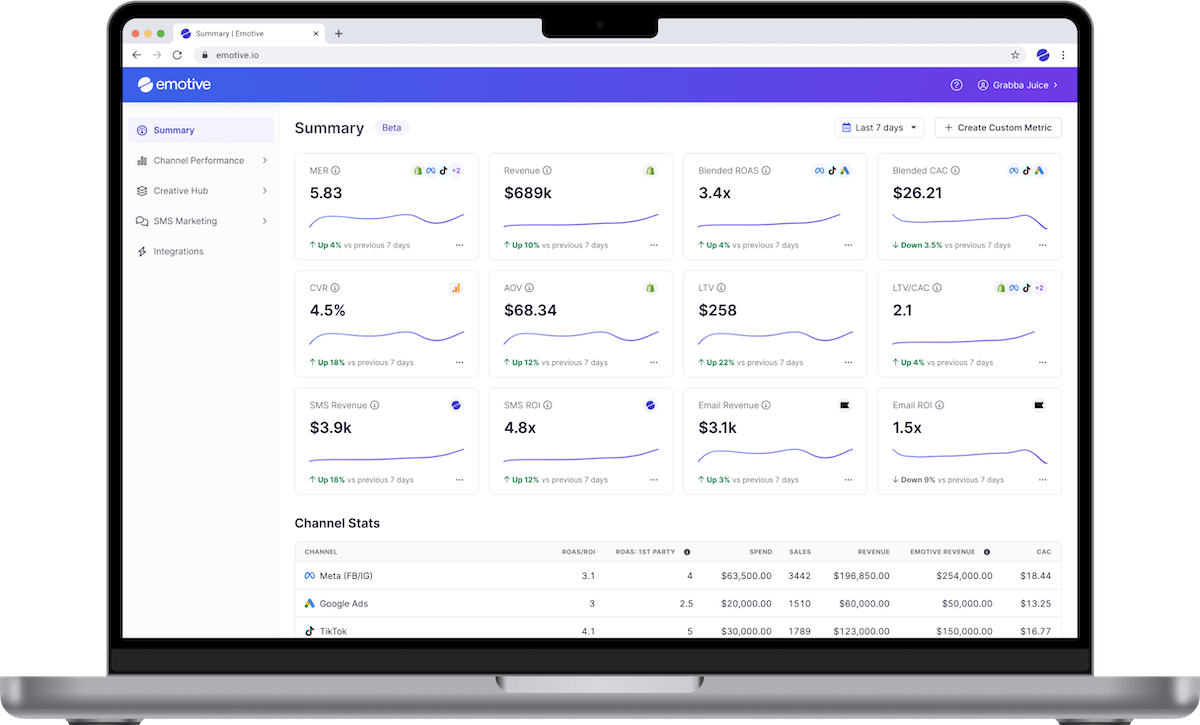With the iOS14 changes last year, growth has gotten even harder for ecommerce brands. Once a reliable, cost effective channel, Facebook targeting options are now limited, costs have risen, and it’s harder than ever to understand performance. Marketers are forced to diversify their marketing channels, which means even more time spent logging into different dashboards, compiling results for performance review meetings, and trying to interpret inconsistent metrics.
Who has time for all that?
Thankfully, there are analytical tools that can help! Ecommerce marketers are increasingly turning to these tools to centralize their data, which cuts down on reporting time and makes it easy to compare results—and make quick decisions on reallocating spend across campaigns and channels. Some tools even offer their own attribution to prevent double counting across channels. They’ll tell you which channel actually drove a sale—whether it’s first click, last click, linear, impression tracking, or the option of all four!
There are a variety of options out there, so it’s critical that you choose the right analytical tool for you. Here are 4 things to consider when choosing an analytical tool for ecommerce marketing:
1. Who is this tool built for?
Not all analytical tools are built for ecommerce. Some won’t offer the integrations and metrics you need to get the full picture of how your channels are performing. As a first step, make sure the tool you choose is designed to serve ecommerce brands.
Once you find an analytical tool for ecommerce businesses, you’ll want to know who on your ecommerce team it’s built for. Is it built for the founder, giving them only topline numbers? Or is it built for the marketer, giving data and metrics that go deeper? Not everyone on the team has the same needs, so it’s important to make sure your analytical tool speaks to the right audience.
2. Which ecommerce and marketing channel integrations does it offer?
If you truly want to centralize your data, it’s critical that your analytics tool integrates with all of your channels.
First up is your ecommerce channel. At one time, you may have only needed to connect with a platform like Shopify, WooCommerce or BigCommerce. But now, to see the full picture, you might also need to connect with platforms like Amazon and others. Make sure your analytical tool has this capability.
Next up are your advertising channels. These might include Facebook, Instagram, Google, Snapchat, TikTok, and Pinterest. Make sure your analytical tool will integrate with every channel you use—the more channels it integrates, the fewer channels you have to check on your own!
Finally, there’s your lifecycle marketing, including email and the increasingly popular SMS. Make sure your analytical tool integrates with these as well, or you’ll see gaps in your data.
3. Does it have an attribution offering?
If you’re relying on reporting from each channel, you’re likely seeing some overlap. That’s because channels aren’t as consistent in their reporting as you need them to be, and often don’t take other platforms into consideration.
For example, if you added up all of your sales from each channel it might be double (if not triple!) the total amount you’re seeing from your ecommerce platform. Unfortunately, each channel counts attribution differently, and doesn’t take into account the impact from other channels.
Ecommerce marketers should look for analytics tool that has its own attribution offering. These tools will be able to tell you which channel (or mix of channels) actually drove the sale, to avoid multiple channels taking credit for the same sale.
4. Does it offer insights, or just data?
There are plenty of tools that consolidate data, but not all of them are helpful at providing insights. Insights help you more quickly analyze the data, telling you where to spend, how much to spend, why performance might be up or down, and giving other helpful tips.
Ecommerce marketers need to make sure their analytical tools offer super simple ways to understand how to best allocate spend, so you can more easily boost growth! Check to be sure yours offers the insights you need to be most effective.
Remember: there are a variety of options for analytics tools on the market, but not all will fit your needs. Be sure to consider the four factors above when choosing an analytical tool for ecommerce marketing.
Introducing Emotive Analytics
Here at Emotive we started as a conversational SMS marketing provider, but, after listening to feedback from customers, we’re quickly expanding. Brands report that although SMS drives significant revenue for them, it’s sometimes not enough to help them overcome the changing landscape of ecommerce and marketing.
That’s why we’re excited to launch Emotive Analytics!

Our team recognized that ever since iOS14, our customers’ needs had changed. Growth became substantially harder, and analytics were a huge part of that challenge.
Emotive Analytics is precision-designed to provide ecommerce marketers with the specific data and insights they need to be successful, including:
One central dashboard that shows all of your analytics, making it incredibly easy to optimize spend and grow faster—view Facebook, Instagram, Google, TikTok, Snapchat, Pinterest, SMS, and email performance all in one place, saving you tons of time (with more channels coming soon!).
Enough data for digital marketers who are controlling the spend, but also a high level overview to keep founders and CMOs happy.
No more double counting. Emotive Analytics’ attribution shows you which channel (or mix of channels) drove a sale, so you know where to allocate spend. And, our pixel tracks your first-party data and sends it back to the ad networks to help improve targeting!
Plus, we don’t just give you the data, we provide insights to help you make decisions—right in the dashboard. You can also tap into insights from our team of marketing experts, to help guide you!
Ready to get the best analytical tool for ecommerce marketing? Join our waitlist today to get early access to Emotive Analytics. Be one of the first marketers to see how you can accelerate growth with a centralized dashboard!







